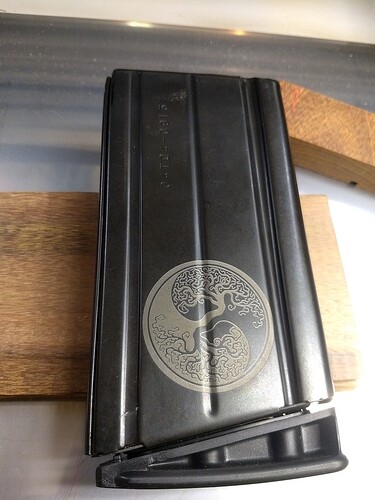I finally got up the courage to try and engrave on some steel. These are FN mags. I’m not sure what the the finish treatment is.
Settings: 500/full 340lpi. No mask or prep. Focus right at the surface.
That’s about right on for painted metals. Nice result. Did you wipe them down afterward? I find a quick denatured wipe cleans the metal up and makes it more silvery… removes the last of the paint residue.
I don’t think these are painted. It doesn’t come through in these photos, but the surface looks similar to a traditional blued steel. There is no change in surface height, it’s still a continuous smooth surface.
Interesting. I might still try the alcohol, you know, for science 
NIce etching–looks like gun parts use either Blueing or Parkerizing… but recommendations seem to be to seal the now exposed steel to prevent rust, since the etching removed the protective coating meant to prevent rust!
Nice job.
So some quick reading, and that seems to be the “hot” bluing technique: “The “Hot” process is an alkali salt solution using potassium nitrite or sodium nitrate and sodium hydroxide, referred to as “Traditional Caustic Black”, that is typically done at an elevated temperature, 135 to 155 °C (275 to 311 °F). This method was adopted by larger firearm companies for large scale, more economical bluing. It does provide good rust resistance which is improved with the use of oil.” from wikipedia. Anyway, sounds like a similar process to anodization from a laser standpoint, but you should probably wipe down and then apply a thin oil coat to protect against rust. Looks super sharp. Did this require removal of the tray? (no idea how thick a FN Mag is)
Thanks for the lookup, this definitely appears to be a “caustic black” style of finish. I’m curious to see whether there is a significant reduction in corrosion protection. I’ll oil the main prints, but leave my test area as is and see what happens. Worst case, I’ll need to remove some oxidation and oil it.
Yes, it was necessary to remove the tray. I use a dial indicator and a magnetic support arm to set focus height. Zero on the dial is set to the tray height, then the target is shimmed up until it lands in the .5" window and the measurement on the indicator is the focus height. This method makes it really quick to swap the tray in and out.

